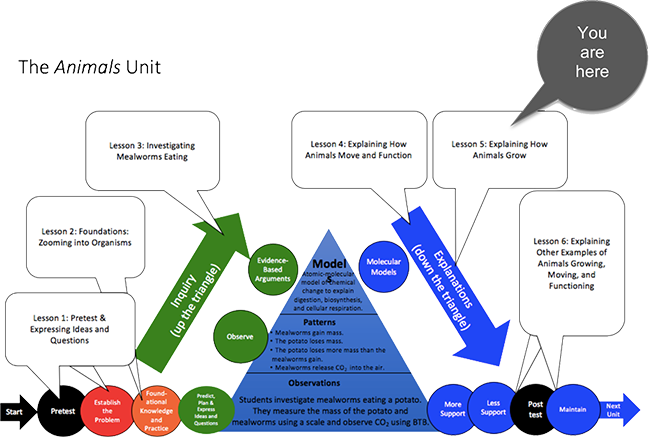Transformations in Matter and Energy Carbon TIME is an NSF-funded partnership led by Michigan State University
]Lesson 5 - Explaining How Animals Grow
Students learn and use a scientific model to explain digestion and biosynthesis using the Three Questions.
Guiding Question
How do animals use food to grow?
Activities in this Lesson
- Activity 5.1: Tracing the Processes of Cows Growing: Digestion and Biosynthesis (40 min)
-

 Activity 5.2: Molecular Models for Cows Growing: Digestion and Biosynthesis (40 min)
Activity 5.2: Molecular Models for Cows Growing: Digestion and Biosynthesis (40 min) - Activity 5.3: Explaining How Cows Grow: Digestion (40 min)
- Activity 5.4: Explaining How Cows Grow: Biosynthesis (40 min)
Note: The molecular modeling part of Activity 5.2 is exactly the same as the molecular modeling for biosynthesis in the Plants and Decomposers units. Additionally, it is a 2-turtle activity which means it involves a higher level of complexity. Consider skipping the activity if you have already taught it in another unit or if it is too advanced for your class.
Unit Map

Target Performances
|
Lesson 5 – Explaining How Animals Grow (students as explainers) |
|
|---|---|
|
Activity 5.1: Tracing the Processes of Cows Growing: Digestion and Biosynthesis |
Students “zoom in” to the structure and function of a cow’s organ systems and cells, tracing atoms and energy. |
|
Optional Activity 5.2: Molecular Models for Cows Growing: Digestion and Biosynthesis |
Students use molecular models to explain how polymers are broken into monomers during the process of digestion and monomers are linked into polymers during biosynthesis. |
|
Activity 5.3: Explaining How Cows Grow: Digestion |
Students explain how matter moves and changes and how energy changes during digestion in a cow (connecting macroscopic observations with atomic-molecular models and using the principles of conservation of matter and energy). |
|
Activity 5.4: Explaining How Cows Grow: Biosynthesis |
Students explain how matter moves and changes and how energy changes during biosynthesis in a cow’s cells (connecting macroscopic observations with atomic-molecular models and using the principles of conservation of matter and energy). |
NGSS Performance Expectations
Middle school
- MS. Matter and its Interactions. MS-PS1-1. Develop models to describe the atomic composition of simple molecules and extended structures.
High school
- HS. From Molecules to Organisms: Structures and Processes. HS-LS1-2. Develop and use a model to illustrate the hierarchical organization of interacting systems that provide specific functions within multicellular organisms.
- HS. From Molecules to Organisms: Structures and Processes. HS-LS1-6. Construct and revise an explanation based on evidence for how carbon, hydrogen, and oxygen from sugar molecules may combine with other elements to form amino acids and/or other large carbon-based molecules.
Talk and Writing
This lesson of the unit represents the fading portion of the Explanations Phase. This means that students are expected to develop explanations for carbon-transforming processes they studied in this unit in new and novel contexts. The table below shows specific talk and writing goals for the Explanations phase of the unit.
|
Talk and Writing Goals for the Explanations Phase |
Teacher Talk Strategies That Support This Goal |
Curriculum Components That Support This Goal |
|---|---|---|
|
Examine student ideas and correct them when there are problems. It’s ok to give the answers away during this phase! Help students practice using precise language to describe matter and energy. |
Let’s think about what you just said: air molecules. What are air molecules? Are you talking about matter or energy? Remember: atoms can’t be created. So that matter must have come from somewhere. Where did it come from? Let’s look at the molecule poster again… is carbon an atom or a molecule? |
Molecule Poster Three Questions Poster
|
|
Focus on making sure that explanations include multiple scales. |
The investigation gave us evidence for what was happening to matter and energy at a macroscopic sale. But what is happening at an atomic-molecular scale? What is happening to molecules and atoms? How does energy interact with atoms and molecules during chemical change? Why doesn’t the macroscopic investigation tell us the whole story? Let’s revisit our scale poster… what is happening to matter at the molecular scale? |
Molecular Models Molecular Modeling Worksheets Explanations Tool PPT Animation of chemical change Powers of Ten Poster |
|
Encourage students to recall the investigation. |
When did this chemical change happen during our investigation? How do we know that? What is our evidence? What were the macroscopic indicators that this chemical change took place? |
Evidence-Based Arguments Tool Investigation Video |
|
Elicit a range of student explanations. Press for details. Encourage students to examine, compare, and contrast their explanations with others’. |
Who can add to that explanation? What do you mean by _____? Say more. I think you said _____. Is that right? Who has a different explanation? How are those explanations similar/different? Who can rephrase ________’s explanation? |
Explanations Tool |

 Download PDF of Lesson 5 Teacher's Guide
Download PDF of Lesson 5 Teacher's Guide